For 100 years, women have embraced fashion that was once only considered appropriate for men, like suits, military jackets, blue jeans, and brogues. Why hasn’t it become the norm for men to take on traditionally feminine clothing? Will it ever be socially acceptable for more men to wear skirts and dresses?
These are some of the questions that Michelle Finamore asked as she curated the Gender Bending Fashion exhibit at Boston’s Museum of Fine Arts. The exhibition is a psychedelic experience. The space is moody and dark, with green, yellow, and red neon lights illuminating faceless mannequins, crafted by the MFA’s in-house designer Chelsea Garunay. Finamore chose to take an ahistorical approach to fashion: Outfits from different moments over the past century sit beside each other, with ’90s men’s kilts next to a women’s bicycling ensemble from 1900. Interspersed among everyday looks are clothes by designers that have played around with gender norms, including Christian Siriano, Yves Saint Laurent, Rick Owens, Rei Kawakubo for Commes Les Garcons, and Alessandro Michele for Gucci.
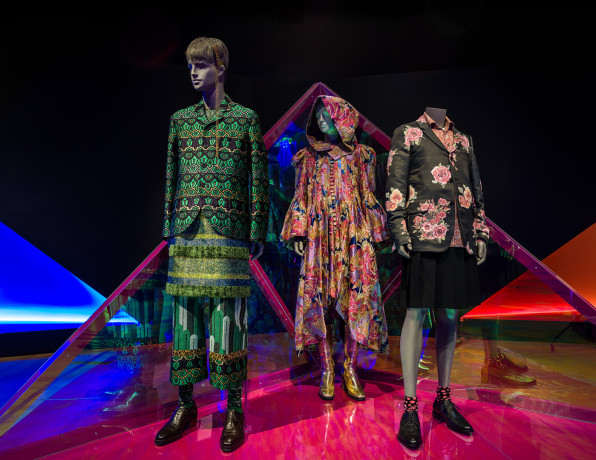
This allows the viewer to see the outfits out of their context–and better identify patterns. And it quickly becomes clear that there are recurring motifs. The dark suit, with its boxy shoulders and sharp angles, comes to represent masculine dress. Meanwhile, colorful patterns and flowing robes embody the feminine. But these two forms of dress are slowly colliding in our current moment. The future of fashion appears to be neither masculine, nor feminine, but an intriguing hybrid of the two.
The Armor of Patriarchal Power
The dark business suit is a relatively recent phenomenon. Finamore, who studies clothing in the 20th and 21st century, believes that our culture has transformed the suit into a symbol of patriarchal power. Before the 19th century, European aristocratic men tended to wear colorful, frilly outfits, along with wigs that gave the appearance of long hair. But then, in the early 1800s, wealthy men began wearing well-cut tailored suits in somber colors, like black, gray, and blue. This is still true today, particularly in male-dominated industries like finance, consulting, and law. The shift occurred during the period after the industrial revolution, when middle-class women were increasingly relegated to the home, while men were out in public spaces working. “There was this idea that colors and patterns were frivolous, and something that women cared about,” Finamore points out. “So these things came to be characterized as feminine.”
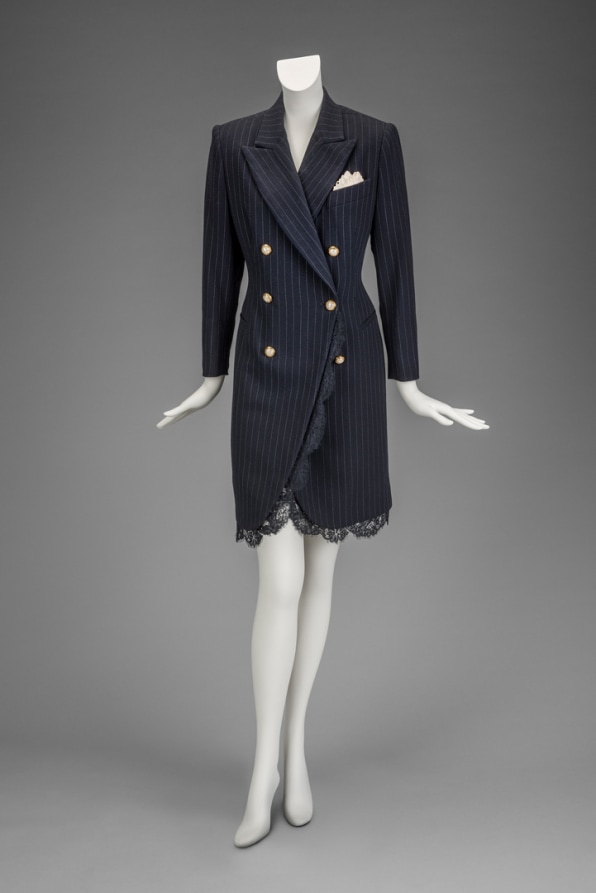
While women have gladly taken on the iconic male garment of our time, men, for their part, have not been as adventurous. In fact, men seem to be clinging onto the suit–and offshoots of it, like the blazer and the chino–as their standard form of dress. Not only are these clothes carefully designed to facilitate movement, they also project power and authority toward others. “The business suit has become so entrenched in Western culture and now in non-Western cultures, too,” says Finamore. “Men are loathe to give that up.”
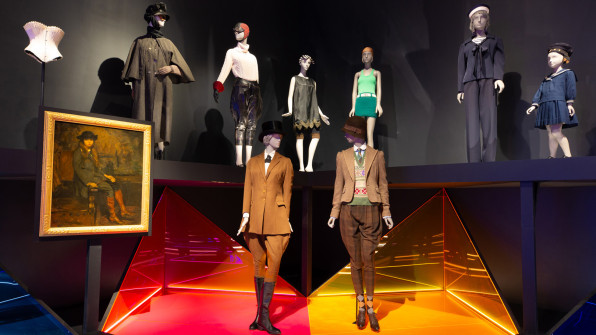
How Women Got On Board With Male Clothes
But even as men have stubbornly stuck to traditionally masculine clothing, women have been eager to adopt the clothes of their male counterparts. As the exhibit shows, women often adopted male garments because they were more practical and allowed women to move more freely. For instance, women first gave up their skirts and petticoats because they wanted to take part in outdoor activities, like bicycling or fox hunting by horseback. Under neon lights, there is a painting of a young woman from the late 1800s wearing a man’s horseback riding getup, including trousers and boots. Her long hair is in a ponytail, and her face is delicate and feminine. The message seems to be that it is not particularly transgressive for a woman to wear men’s garments. It is just a matter of functionality.
World War II fast-tracked women’s adoption of men’s clothing. When men went off to fight, women took up the work they left behind, like joining the police force and becoming mechanics. Suddenly, it was normal to see women wearing men’s uniforms, which included suits and jumpsuits.
All of this has paved the way for women of our time to pick from any part of fashion history they like. This is perhaps why women’s fashion weeks around the world are a far more colorful, exciting, and creative experience, with designers mixing traditionally masculine and feminine silhouettes from different eras.
Consider the women’s fall 2019 ready-to-wear shows at New York Fashion Week. The dark business suit was very much in vogue. Chanel, Alexander McQueen, and Balenciaga all played around with suits, sending women onto the runway with boxy blazers. One Rick Owens ensemble featured a blazer on top of a bodysuit and no trousers. But other designers created highly feminine outfits. Paco Rabane sent models out in flowing floral dresses. Rodarte created frilly white gowns full of lace, as well as headbands that looked like halos and shoulder pads that looked like angel’s wings.
The men’s shows, on the other hand, were largely variations of the suit. Alyx created a suit out of leather. Berluti created a suit with a bronze polished exterior. Alexander McQueen created a suit out of layers of houndstooth fabrics. There were only a couple of outliers. Palomo Spain sent a male model out in a floral bohemian gown, and Thom Browne created long white futuristic gowns. But these were exceptions that proved the rule: Men’s fashion is more reluctant to bend gender norms.
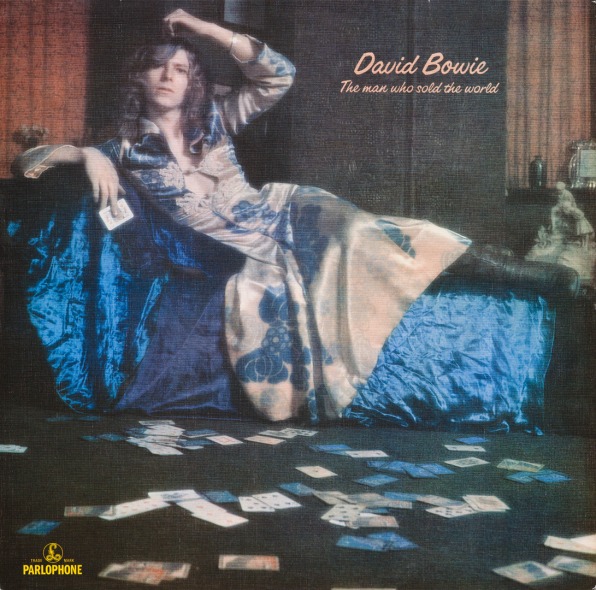
Brief Antiestablishment Sentiment
What does it take to get men to abandon their loyalty to the suit, and become more adventurous with their clothing? Finamore says that the last century offers a couple of clues.
In her analysis, she has observed only a few moments when men have been willing to embrace color, patterns, and flowing silhouettes. The most obvious example is during the 1960s and 1970s, which is sometimes known as the Peacock Revolution in menswear. Men began growing out their hair and wearing colorful, often sexualized clothes that were unlike anything men had worn over the previous century.
The exhibit features pictures of young men wearing floral patterns and trousers with bell bottoms that added curves to an otherwise very staid garment. The most extreme version of this trend can be seen in the 1970 David Bowie album cover for The Man Who Sold the World, which features Bowie in a long floral dress, boots, and long, curly hair. “Ideas about masculine clothing were challenged,” says Finamore.
As Finamore tells it, these moments are related to larger cultural developments. During this era, the rejection of traditional masculine clothing was a way for young men to express their opposition to the establishment, particularly suit-wearing politicians and corporate leaders. Again, the suit was symbolic of patriarchal power, but young men at the time were uneasy with what their patriarchs were doing.
By the 1980s, this challenge to traditional menswear had faded away. In fact, Finamore sees a kind of overcorrection to these more flamboyant styles, as menswear brands reverted to much more traditionally masculine looks. For instance, the high-end Italian suiting company Brioni created colorful floral suits in the 1960s and 1970s, but from the 1980s onward, Brioni suits have rarely strayed from dark colors and angular cuts.
Another Fashion Revolution?
Finamore proposes that we are currently in a moment when young, politically active people are pushing back against the authority, fighting for things like stricter gun laws, women’s rights, and marriage equality. And yet, strangely, we’re not seeing the same kind of radical rejection of traditionally masculine clothing. “We haven’t seen men adopting more colorful attire on a wide scale,” she says. “We haven’t seen them wearing skirts, for instance.”
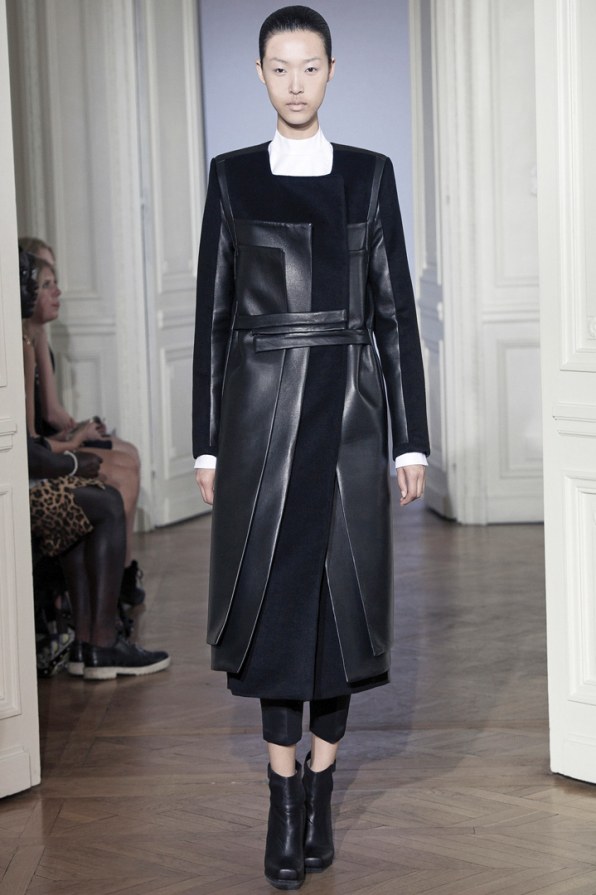
The future of fashion, then, is a more subtle blending of masculine and feminine looks. Men and women are already wearing very similar clothes, and every so often, traditionally feminine colors and silhouettes have a way of sneaking into menswear in almost imperceptible ways. Take, for instance, the work of Jordanian-Canadian designer Rad Hourani, whose work is on display in the exhibit. He describes his clothes as genderless, which means creating an aesthetic that doesn’t look particularly masculine or feminine. He’s known for his coats, which have a flowing drape and seem both reminiscent of a military trench coat and a gown. It’s neither here nor there.
https://www.fastcompany.com/90338438/what-will-it-take-for-more-men-to-wear-skirts
2019-04-24 12:00:00Z
CAIiEMA1riQpSFfbCgB32hfEKdoqFQgEKg0IACoGCAowlacCMKBPMOGbAg
Tidak ada komentar:
Posting Komentar